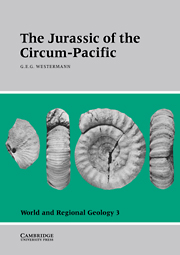Book contents
- Frontmatter
- Contents
- List of contributors
- Preface
- Acknowledgments
- Introduction
- Part I Time scales
- Part II Circum-Pacific base map
- Part III Regional geology and stratigraphy
- Part IV Biochronology
- Part V Biogeography
- 18 Macroflora of eastern Asia and other circum-Pacific areas
- 19 Ostracods and foraminifers of Western Interior North America
- 20 Ostracods of China
- 21 Corals of the circum-Pacific region
- 22 Brachiopods of the circum-Pacific region
- 23 Belemnites of the circum-Pacific region
- 24 Ammonites of the circum-Pacific region
- 25 Fishes of the circum-Pacific region
- 26 Marine reptiles of the circum-Pacific region
- Part VI Climatology and oceanography
- Appendix: Biochronology and atlas with index and guide fossils
- General Index
- Index of Guide- and Indexfossils
18 - Macroflora of eastern Asia and other circum-Pacific areas
Published online by Cambridge University Press: 04 August 2010
- Frontmatter
- Contents
- List of contributors
- Preface
- Acknowledgments
- Introduction
- Part I Time scales
- Part II Circum-Pacific base map
- Part III Regional geology and stratigraphy
- Part IV Biochronology
- Part V Biogeography
- 18 Macroflora of eastern Asia and other circum-Pacific areas
- 19 Ostracods and foraminifers of Western Interior North America
- 20 Ostracods of China
- 21 Corals of the circum-Pacific region
- 22 Brachiopods of the circum-Pacific region
- 23 Belemnites of the circum-Pacific region
- 24 Ammonites of the circum-Pacific region
- 25 Fishes of the circum-Pacific region
- 26 Marine reptiles of the circum-Pacific region
- Part VI Climatology and oceanography
- Appendix: Biochronology and atlas with index and guide fossils
- General Index
- Index of Guide- and Indexfossils
Summary
Studies of Mesozoic plants have for a long time centered on Europe, where every Mesozoic flora was regarded as a world standard, such as the Yorkshire flora. Studies of the Mesozoic plants and floras of the circum-Pacific regions have advanced rapidly during the past three decades, and many new data are now available. Representative specimens are illustrated in Plates 96–98.
In Japan, Mesozoic plants are generally abundant, though not throughout the section, and they occur mostly in marine strata or in plant beds sandwiched between marine beds (Kimura 1987, 1988). Elsewhere in the Pacific region, Mesozoic plant beds are nonmarine and thus difficult to date precisely. In most Mesozoic plant assemblages of Japan the details of reproductive organs of ferns and cuticles of gymnosperms have been lost because of tectonic and repeated igneous activities. Most Mesozoic floras of Japan, of every period and stage, may nevertheless be regarded as the most important ones in the Pacific.
In this chapter, Kimura reviews the current status of the Japanese Jurassic floras and that of coeval floras in other cirum- Pacific regions, and Lebedev, Markovich, and Samylina review the Jurassic floras in the Pacific sector of Russia.
Early Jurassic
Japan
Early Jurassic plants are known from the Higashinagano Formation and the lower part of Shizugawa Group, but they are rare and insignificant (Figure 18.1).
- Type
- Chapter
- Information
- The Jurassic of the Circum-Pacific , pp. 311 - 316Publisher: Cambridge University PressPrint publication year: 1993

